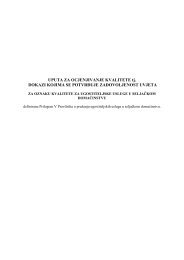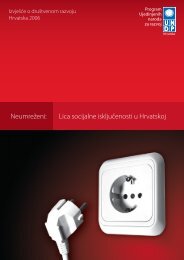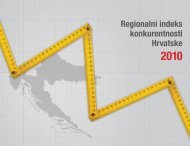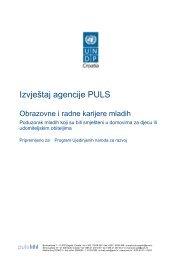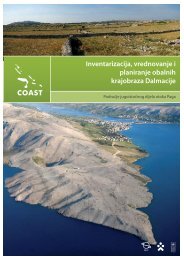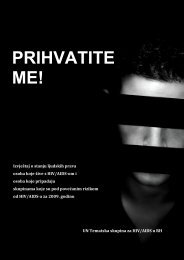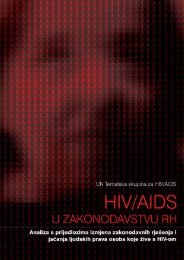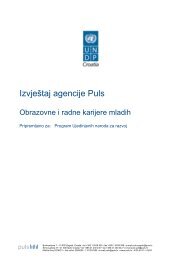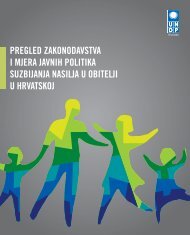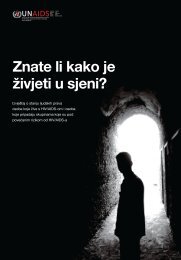THE SOCIALLY EXCLUDEDCHAPTER 3The housing fund available to the Roma mostlyconsists of houses (74.5%), shacks (9.5%), abandonedcabins on construction sites (9%), and apartments(6%). 63 However, most houses do not meet even theminimum building codes: 11% of households with anaverage of five members live in 10m 2 , and at least 54%of persons live in overcrowded housing spaces. 64If the-above mentioned data were viewed cumulativelyin accordance with the FEANTSE typology (Europeantypology on homelessness and housing), it canbe said that most members of the Roma minority livean insecure existence. Although the exclusion of housinghas been recognised, it is primarily viewed fromtwo standpoints. The first is “wild construction” as anexpression of the “Roma cultural code”. The second isfrom the general measures regarding housing, wherethere is a t<strong>end</strong>ency to find a solution within the narrowcontext of the Roma, leading to further ghettoisation.Examples of where the Roma themselves are consultedabout the process and where the social dimension ofhousing is taken into account are few and far between.Some representatives of the Roma have proposed theintroduction of a system which would provide specificloans, and investments in kind, including free work bythose Roma who decide to participate in the proposedprogramme.The entire area liberated in the Operation Storm in 1995was devastated, and even the most basic infrastructureis destroyed there. The reconstruction of houses is relativelyslow, due partly to certain administrative hurdles.For example, only the houses of Serb returnees builtwith building permits and which were entered in theproperty registers are being reconstructed. However,in the 1970s and the 1980s, which is when most of thehousing in the area was built, it was quite common tobuild houses without permits, and not to keep propertyregisters up to date. The absence of even the basic municipalinfrastructure, which existed before the war, is anadditional obstacle preventing returning families fromleading a normal life in these sparsely settled areas.3.2.9 Social Ties“We are all for one and one for all. We have learnedto stick together, because that is the only way wecan survive.”(Participant of the focus group, Sisak, <strong>UNDP</strong>, 2006b)The social interaction between the Roma and thenon-Roma seems to be based on a fundamental lackof mutual understanding. The majority populationhas the impression that the Roma have internalisedtheir way of life over the centuries and that they donot want to do anything to change it; consequently,any integration attempts, the majority thinks, wouldbe unsuccessful. The Roma express their concerns regardingthe integration process, because the majoritypopulation is not sufficiently informed about theirsituation or their identity. Voices that communicatethe reality of different Roma communities mostlycome from the non-governmental sector, which havevested interests in the topics they promote. A lack ofconsensus on certain topics amongst representativesof the Roma is frequently mentioned as an exampleof the Roma “irrationality” in their fight for greaterresources, but this is not much different from theparticipation of other marginalized groups.Serb returnees in the Knin and Glina region have returnedto what are extremely sparsely-settled areas.Before the war, the area was sparse, while during thewar it was demographically devastated. It is difficultto make social contact in demographically devastatedareas. There are three closed communities living nextto each other within the same area: the autochthonousCroats, Serb returnees, and Croats who movedfrom Bosnia and Herzegovina. Members of thesethree communities do not have much contact witheach other, however the recent period has seen theappearance of some form of “political correctness”and meta-language trying to conceal the gap.63 Geran-Marko Miletić, (2005): Uvjeti stanovanja i stambene aspiracije Roma, p. 163, u Kako žive hrvatski Romi64 Ibid.51
CHAPTER 3THE SOCIALLY EXCLUDED52Apart from the basic demographic devastation of theentire area, there are also subregional movements.Subregional centres are appearing, in which the populationnumbers are stagnant, but the neighbouringareas remain completely empty. The community ofautochthonous Croats and the community of Croatsfrom Bosnia and Herzegovina are far more mobile interms of space than the Serb returnee community.This community t<strong>end</strong>s to remain in remote hamlets,where it is not possible to have interpersonal contact.During the planning of their return, the possibility ofconcentrating returnees in bigger settlements wasnot considered, and in sparsely populated areas it ismore difficult to guarantee the needed infrastructure.The isolation of settlements open to returnees is thereason why it is mostly elderly people who return.3.2.10 Political ParticipationThe <strong>Croatia</strong>n political system protects the passivevoting right of members of national minorities byensuring a pre-reserved number (of at least 5, at most8, which is the number elected) of representativesin the Parliament. The members of minorities mustdecide whether they want to vote with other citizensin regular electoral units or for candidates in specialunits for minority candidates. The Serb minority electsthree representatives, the Italian and Hungarians haveone representative each, while other minorities aregrouped into electoral units where several minoritieselect one representative. Minority representatives areelected from the electoral unit (by simple majorityvote) regardless of the number of votes they win.There are also several other dilemmas regarding theway representatives are elected at the national level.The prevention of positive discrimination of minoritiesby their right to vote two ways, pushes the minoritiesinto a difficult situation: the ghettoisation of their minorityor forced assimilation. This is because by votingonly in a small electoral unit they waive their right tothe general electoral vote and political identity, and byvoting only in regular electoral units they waive theiridentity as minorities.At the level of local and regional government, the ConstitutionalAct foresees the right of minorities to proportionalrepresentation in representative and executivebodies, everywhere where minorities account formore than 15% of the population. The intention of thelegislation was to replace the principle of democracyby the majority, in the parts of the country where thereis a significant minority presence, with the principle ofconsolidated community governance. However, theprinciple of proportional representation is complicatedby question of how minority quotas should becalculated to determine their level of representation.If representation were based on the most recent voterlists, minority representation in local assemblies wouldbe significantly higher in war-affected areas, wheremany refugees have returned since 2001. This questionis currently before the Constitutional Court for reviewand adjudication, at the request of the NGO GONG andthe National Council for National Minorities, mandatedby the CLNM to support and co-ordinate the participationof minorities in public life at the national level.The third “pillar” of minority representation – minorityself-government, i.e., the council of national minorities– is envisaged as a link between civil society andlocal government. The legislator has enabled a highdegree of fiscal autonomy for minority self-governments,which they do not use (SDF, 2006), andconsequently the self-sustaining capacities for theseinstitutions are very low. The connection betweenminority NGOs and minority self-governments hasbeen lost, and there is no awareness of the non-partycharacter of minority self-government. Neither themembers of representative and executive bodies oflocal and regional governments, nor the members ofminority self-governments, fully understand the intentionof the legislator in that minority self-governmentsshould not function as authorities. Rather, theyshould act as a consultative body which contributesto the introduction of the principle of participatorydemocracy and the European principle of good governancein the <strong>Croatia</strong>n local government.3.2.11 Key ChallengesIn the previous decade, <strong>Croatia</strong> has made the mostprogress in the official protection of minority rights.The implementation of the principle of the rule of lawand the affirmation of the mechanisms for minorityprotection are the basic obligations of the <strong>Croatia</strong>nstate in the near future. In addition to creating officialprotection, <strong>Croatia</strong> has made significant progressin the openness of media, and in the correctness ofsocial communication. Hate propaganda, quite commonin public discourse concerning minorities untilrecently, has become a sporadic phenomenon.



